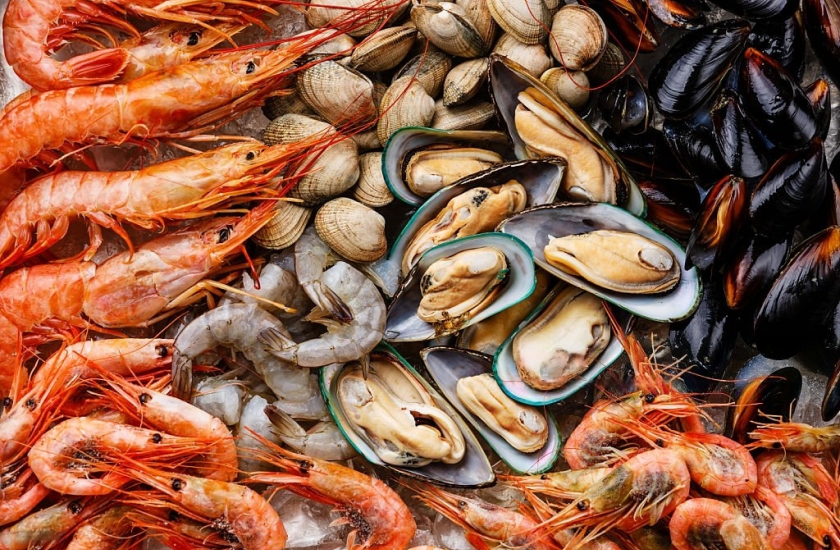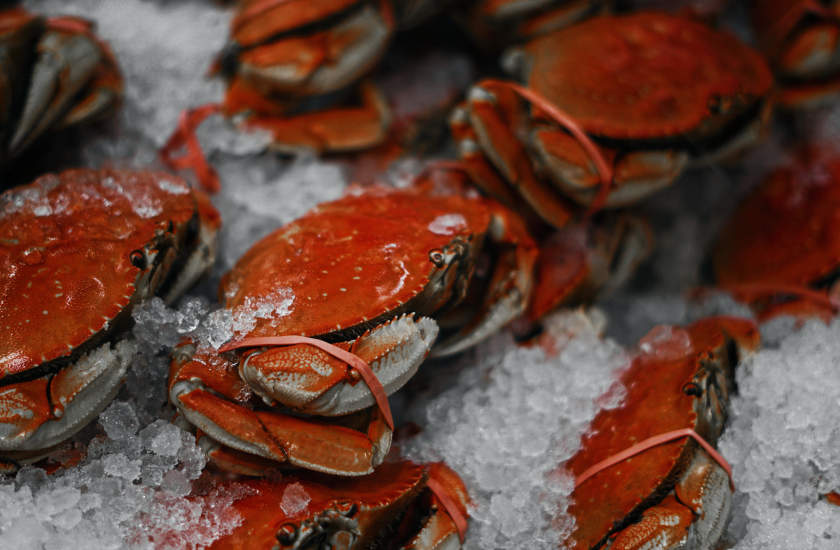Seafood
-
Beefs
Beefs
-
Chicken
Chicken
-
Pork
Pork
-
Eggs
Eggs
-
Fish
Fish
-
Lamb
Lamb
-
Goat Meat
Goat Meat
-
Honey
Honey
-
Sea Food
Sea Food
-
Milk
Milk
-
Cheese
Cheese
-
Yogurt
Yogurt
Our Brochures
Contact Us
Social Media


Seafood is any form of sea life regarded as food by humans, prominently including fish and shellfish. Shellfish include various species of molluscs (e.g., bivalve molluscs such as clams, oysters and mussels, and cephalopods such as octopus and squid), crustaceans (e.g. shrimp, crabs, and lobster), and echinoderms (e.g. sea cucumbers and sea urchins). Historically, marine mammals such as cetaceans (whales and dolphins) as well as seals have been eaten as food, though that happens to a lesser extent in modern times. Edible sea plants such as some seaweeds and microalgae are widely eaten as sea vegetables around the world, especially in Asia.
Seafood Characteristics
The harvesting of wild seafood is usually known as fishing or hunting, while the cultivation and farming of seafood is known as aquaculture and fish farming (in the case of fish). Most of the seafood harvest is consumed by humans, but a significant proportion is used as fish food to farm other fish or rear farm animals. Some seafoods (i.e. kelp) are used as food for other plants (a fertilizer). In these ways, seafoods are used to produce further food for human consumption. Also, products such as fish oil, spirulina tablets, fish collagen, chitin are made from seafoods. Some seafood is fed to aquarium fish, or used to feed domestic pets such as cats.
Seafood Production
Seafood is consumed all over the world; it provides the world’s prime source of high-quality protein: 14–16% of the animal protein consumed worldwide; over one billion people rely on seafood as their primary source of animal protein. Shellfish are particularly rich in zinc, which is essential for healthy skin and muscles as well as fertility.
Seafood Health benefits
There is broad scientific consensus that docosahexaenoic acid (DHA) and eicosapentaenoic acid (EPA) found in seafood are beneficial to neurodevelopment and cognition, especially at young ages. Seafood consumption is associated with improved neurologic development during pregnancy and early childhood and more tenuously linked to reduced mortality from coronary heart disease.
The parts of fish containing essential fats and micronutrients, often cited as primary health benefits for eating seafood, are frequently discarded in the developed world. Micronutrients including calcium, potassium, selenium, zinc, and iodine are found in their highest concentrations in the head, intestines, bones, and scales.
Government recommendations promote moderate consumption of fish. The US Food and Drug Administration recommends moderate (4 oz for children and 8–12 oz for adults, weekly) consumption of fish as part of a healthy and balanced diet. The UK National Health Service gives similar advice, recommending at least 2 portions (about 10 oz) of fish weekly. The Chinese National Health Commission recommends slightly more, advising 10–20 oz of fish weekly.
Types of Seafood
Fish are aquatic vertebrates which lack limbs with digits, use gills to breathe, and have heads protected by hard bone or cartilage skulls. Marine pelagic, marine demersal, diadromous, freshwater.
Molluscs are invertebrates with soft bodies that are not segmented like crustaceans. Bivalves and gastropods are protected by a calcareous shell which grows as the mollusc grows. Bivalves, gastropods, cephalopods
Crustaceans are invertebrates with segmented bodies protected by hard crusts (shells or exoskeletons), usually made of chitin and structured somewhat like a knight’s armour. The shells do not grow, and must periodically be shed or moulted. Usually two legs or limbs issue from each segment. Most commercial crustaceans are decapods, that is they have ten legs, and have compound eyes set on stalks. Their shell turns pink or red when cooked. Shripms, crabs, lobsters, krill.
